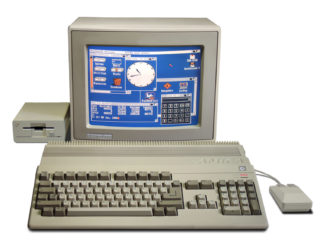This video, via debuglive, offers a great look at how people made jams in 1990 with the Commodore Amiga 500.

The Commodore Amiga 500 was an affordable, mass-market computer, like the earlier Commodore 64. Millions were sold and, soon, there were a variety of hardware and software options for music making.
The video looks at the Amiga 500 hardware, audio cartridges and music making software.
Video Summary:
An Amiga 500, Stereo Master and handful of $1 records from a 1990 Sunday market: Can we make a dance track on a budget home computer?
Of course! Back when big-name dance tunes required big-budget-gear, a secondhand Amiga let you take the first steps to making a dance-floor banger.
If you’ve used the Amiga 500, leave a comment and let us know how you used it!

Back in the day, I got A500, later plus, 2Mb of extra memory and home made stereo sampler. Was banging with trackers. I still have the hardware, the samples I still have, but the tracks got stolen.
1993
ensoniq eps + sony mini disk + Atari Falcon030
and you had become god
So *YOU’RE* the one who bought the Falcon!
Loved my Mega ST4 and Dr T’s.
Hell yeah, I tracked for years. Ripped samples from games & demos, as one did 🙂 (Using Audiomaster to scan the RAM.) OctaMED is the ultimate Amiga tracker. Some folk still use it, you know 🙂
I initially (1989) used an Amiga 500 with Octamed tracker software, later I added an Amiga 1200 that I linked to the 500 using a null modem cable to get more tracks, then I got a couple of Amiga midi interfaces and started getting into synths. Beginning of the end so to speak 🙂
I still have both Amiga’s in storage, I should check to see if they still work.
Back in the day you couldn’t beat and Amiga for its graphic and sound capabilities. It was so far ahead of it’s time. I remember coding games back then. Loved the machine so.much that I still have a couple running today.
Todd Rundgren in Woodstock, NY created a full animatic video studio on his kitchen table with an Amiga 2000 tricked out with accelerator and RAM and the best DAW and video software, a stack of laser disk recorders, and top of the line audio equipment and synthesizers. He created a famous music video Change Myself, the first of its kind, for a total inital cost of about $100,000, which would have cost at least a million dollars to create in a “professional” studio. The home-brew music video studio was born. After that initial cost, all of Todd’s videos only cost time and a little electricity. Change Myself is on U2b. Go watch it.
I used the Amiga 500 with hardware upgrades for creating animations with Deluxe Paint 4 and sequenced my MIDI tracks with Bars & Pipes Professional MIDI sequencer and mastered the results on a 4-head stereo VCR and on audio cassette…
Great comments here! I too loved my Amiga and sampler and Octamed combo. Grabbing samples from games and demos. Writing 12 breakbeat hardcore tracks before dinner. Amiga forever!
I bought my A500 in 1991 and have used it and subsequent models since then to sequence music using Bars & Pipes Professional and various synths
Thank you!
Yamaha C1 here LOL
An a500 with octamed combined with a bunch of CDs and games to grab samples from was pure joy. I also used midi with some synths to complete my setup. Still have my a1200 and am eager to get it serviced and so I’d an relive those days.
We made this hip hop tune on a 500 with a sampler, a Technics and a porta studio in 91. Mostly remember the hassle with midi and timecode! Good times, sampling was so much fun! https://soundcloud.com/djcasca/dol-cashflow
Good old video toaster; the gateway drug 🙂 I upgraded to SGI’s after Amiga’s and Atari’s. Those were the days of real fun DIY computers. Today everything’s shrink wrapped.
this was great to watch. I do kind of miss the art of sampling.
Strangely, I was anti-computer recording for sometime, so instead, I persisted with an EPS, 4 track cassette
and whatever synth I had at the time.
I was probably THE last person to get a PC.
I didn’t start using one for music until 2010!
Amiga + Protracker / Octamed + technosound turbo II sampler ftw!
@ Hiek Jackson: Exactly my setup those days, + Oktalyzer.
I remember what made me buy the Amiga 500 was a demo of Marss Pump up the Volume playing on it and the numeric keys on the keyboard had samples assigned to them, kind of cool for that time.